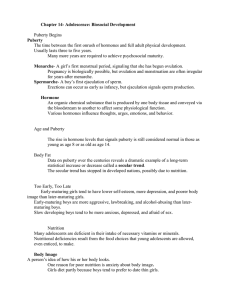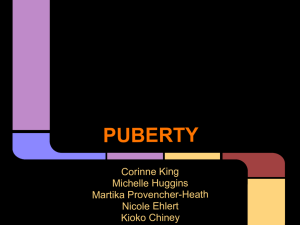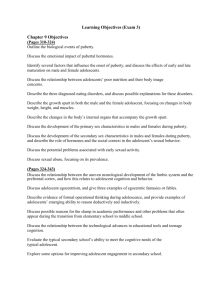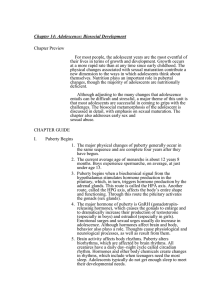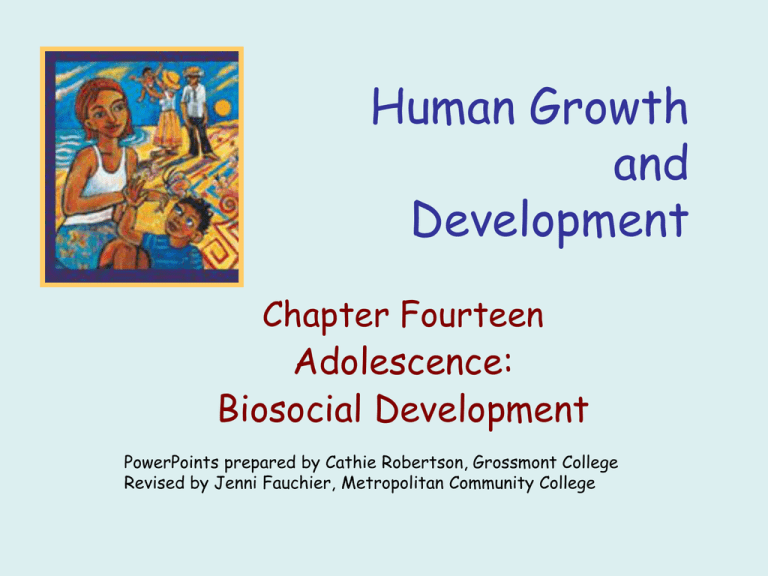
Human Growth
and
Development
Chapter Fourteen
Adolescence:
Biosocial Development
PowerPoints prepared by Cathie Robertson, Grossmont College
Revised by Jenni Fauchier, Metropolitan Community College
Puberty Begins
• Period of rapid physical growth and
sexual maturation
– typically completed three to four
years after first visible signs
• Person attains adult size, shape, and
sexual potential
Hormones
• Puberty begins with hormone
production in brain
– hormones from hypothalamus trigger
production in pituitary glands
– in turn this triggers hormone production
in adrenal glands and sex glands (gonads)
• To regulate body functions and
changes, many hormones follow this
route, the HPA
(hypothalamus/pituitary/adrenal)
axis
Hormones, cont.
• At puberty, the pituitary gland
activates the gonads, or sex glands
(ovaries in females, testes in males)
• One hormone in particular, GnRH,
causes increased production of
estrogen in females and testosterone
in males
Direct Effects on
Emotions
• Rapidly increasing hormone levels
precede rapid arousal of emotions
• Hormonal levels correlate with quick
shifts in emotional extremes
• For boys this increase precipitates
thoughts about sex and masturbation
• For girls hormonal changes during
menstrual cycle produce mood
changes
Indirect Effects on
Emotions
• Hormone levels produce visible signs
of sexual maturation, which in turn
create expectations of new maturity
– social responses to biological signs
trigger adolescent moods and reactions
• One’s culture affects thoughts of
sex
– first sexual intercourse occurs at
different ages in different cultures
The Timing of Puberty
• Normally, body changes begin to
appear between ages 8 and 14
• It’s hard to prepare without knowing
what changes will be and when they’ll
appear
- individual may grow a little taller
and put on some weight
Sex, Genes, and Weight
• Girls on average are about two years
ahead of boys
• Menarche and spermarche
• Timing can be affected by genetics,
ethnicity, and body fat
– individuals with stockier builds
experience puberty earlier
– chronic malnutrition limits fat, thus
delaying puberty by several years
Stress in Families
• Family conflict may cause earlier
onset of puberty or irregular periods
– stress levels affect hormone production
– stress probably affects hormones
causing puberty
• Stress hypothesis gained support
when researchers identified two
factors influencing early puberty
– conflicted relationships with family
– unrelated man living in the home
Too Early or Too Late
• Early-maturing girl may be teased
and is embarrassed
• Age of menarche is a strong
predictor of age at first intercourse
• Late-maturing boys may be shunned
• Early-maturing boys are socially
popular and often sports heroes
Too Early or Too Late, cont.
• Low self-esteem of off-time
maturation lingers
• Early-maturing girls become mothers
sooner
• Late-maturing boys marry later and
are less likely to be leaders
The Growth Spurt
• Defined as a sudden, uneven, and
rather unpredictable jump in the size
of almost every part of the body
Wider, Taller, Then
Stronger
• Increase occurs in bone length and
density
– feet and fingers lengthen, then
arms and legs, then torso
• Weight gain becomes rapid
• Height increase follows
• Timing: for girls, 10–14;
for boys, 12–16
Other Body Changes
• Organ growth
– torso grows as internal organs grow
– lungs triple in weight and size (breathing rate
decreases)
– heart doubles in size (heart rate decreases),
total volume of blood increases
– physical endurance in exercise increases
– lymphoid system decreases in size
– hormones may cause changes in oil, sweat, and
odor glands of the skin
– eyes change—may cause nearsightedness
Primary Sex
Characteristics
• Primary sex characteristics—parts of
the body that are directly involved in
reproduction: vagina, uterus, testes,
penis
• Primary sex organs grow
– girls: uterus grows, vaginal lining thickens
• menarche—first menstrual period
– boys: testes, penis, scrotal sac enlarge
• spermarche—first ejaculation of seminal
fluid
Secondary Sex
Characteristics
• Secondary sex characteristics—body
characteristics not directly involved in
reproduction but indicating sexual
maturity
– breasts
• females accumulate fat
• in both sexes, diameter of areola
around nipples increases
– hair
• voice lowers, especially in males
• body hair becomes coarser and darker
• new hair growth in armpits and in genital
area
Hazards to Health
• Adolescence is generally healthy time
• Minor childhood illnesses less
common; major adult diseases rare
• Health of adolescents is more likely
to be harmed by their own actions
Poor Nutrition
• Need for good, healthy calories is
greater due to growth spurt
– many adolescents become fat and
flabby—due not to excess food, but
lack of exercise
• Adolescents generally eat enough
but not the right foods
– snack with friends
• too much fat, sugar, empty calories;
too little calcium
Poor Nutrition, cont.
• only one in five U.S. high school
seniors consumes RDI of five servings
of fruits and vegetables
• inadequate milk consumption is
troubling, as calcium is major
contributor to bone growth
– one-half adult bone mass acquired
during adolescence
Poor Nutrition, cont.
• fewer than half of all teenagers
consume RDI of iron
– females do not get enough iron,
while menstrual cycle depletes iron;
therefore, may become anemic
Poor Nutrition, cont.
• Nutritional deficits sometimes arise
from distorted body image
– Body Image—person’s concept of
how his or her body appears
– developing a healthy body image is
an integral part of becoming an
adult
• negative-self appraisal has a
major impact on self-esteem
Sex Too Soon
• With puberty occurring earlier than
it used to in the United States, and
marriage later, long period between
first sexual urges and marriage
• More than 25 percent of teens are
sexually active by age 14; about onehalf active by high school graduation
Sexually Transmitted
Diseases
• Sexually active teenagers have higher
rates of most common STDs—
gonorrhea, genital herpes, syphilis, and
chlamydia—than any other age group
• Risk of exposure to HIV virus
increases if a person is
– already infected with other STDs
– has more than one partner in a year
– does not use condoms during intercourse
Teenage Pregnancies
• Younger adolescents within two years
of beginning menarche are at
increased risk for many complications
because their bodies have not
matured
– risks include spontaneous abortion,
eclampsia, stillbirth, C-section, low birth
weight
– women who have given birth before age
16 tend to be shorter and sicker as
adults and live less long
Teenage Pregnancies, cont.
• Older adolescents are at less physical
risk but have their own set of problems
– after birth of baby, educational and
vocational achievement slowed down
– babies have a higher risk of prenatal
and birth complications than other
babies
– problems are linked to culture and
cohort
Sexual Abuse
• Defined as the use of unconsenting
person for one’s own sexual pleasure
• Child sexual abuse—activity that
arouses the adult and excites,
shames, or confuses a person under
age 16
– abusers of adolescent girls—usually
male relative or friend
– abusers of adolescent boys—usually
male not in family
Drug Use and Abuse
• Drug abuse—ingestion of drug so that
it impairs user’s well-being
• Drug addiction—dependence on a drug
or behavior that makes user feel
physically or psychologically at ease
• Drug use—ingestion of a drug
regardless of amount or effect
• Nations differ considerably in use
– in-laws and culture influence usage
– religion influences usage
The Gateway Drugs
• Link between their occasional use
and later drug abuse and addiction
repeatedly found
– characteristics: violence, early
sexual activity, and school
failure
– drug use both cause and
symptom of adolescent problem
The Gateway Drugs, cont.
• Tobacco
–
–
–
–
decreases food consumption
interferes with absorption of nutrients
reduces fertility
most physically addictive drug of all
• Alcohol
– more harmful in adolescence
– correlates with abnormal brain
development
The Gateway Drugs, cont.
• Marijuana
– seriously slows down thinking
processes, especially memory and
abstract reasoning
– may cause lack of motivation and
indifference toward future
Patterns of Adolescent
Drug Use
• Almost every teenager tries one of
the gateway drugs
– by high school graduation, most have
tried all three
– experimentation happening earlier than
previously
• Experimentation and regular use
– daily use and abuse increases
throughout late adolescence
Cultural Differences in
Drug Use
• National culture makes a difference
– In Europe, adolescents show
increased drug use
• adolescent girls in United States as
likely to smoke as adolescent boys; in
Asia and African few women smoke
– drug use changes in frequency,
composition, mode of delivery, and
in form



